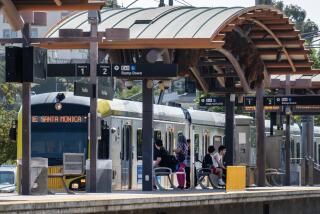More than a fourth of Orange Line passengers ride for free, study finds
More than one-quarter of passengers on the Metro Orange Line may be riding for free, according to the most extensive study to date of fare evasion along the San Fernando Valley bus line.
Los Angeles County Metropolitan Transportation Authority staffers wrote in a new report that, based on two days of checks along the transit line, about 25.9% of passengers either did not have a valid fare or had not paid correctly before boarding. Officials called the discovery frustrating and unexpected.
“I think we’re all disappointed in the results,” Metro chief executive Art Leahy said at a recent downtown meeting. The study suggests fare evasion along the Orange Line could be four times as high as the systemwide figure, which officials have traditionally said is about 6%.
About 30,000 people each day use the Orange Line, which connects commuters in Chatsworth and Woodland Hills with the Red Line subway’s northern terminus in North Hollywood.
Passengers boarding Orange Line buses are supposed to touch their plastic TAP cards to a waist-height pillar that automatically deducts the fare from a pre-paid account. The platforms have no turnstiles to prevent passengers from boarding without paying, and the buses do not have fare boxes.
“I’m not sure it’s all malicious,” said Ann Sheridan of Sherman Oaks as she waited for a bus at the Canoga Orange Line station in Woodland Hills. “Some people may not even realize where to pay.”
During two days in December, uniformed and plainclothes Los Angeles County Sheriff’s Department deputies checked fares at five different Orange Line stations.
According to data reviewed by The Times, 12% of riders stopped during the study did not have a TAP card or had no money loaded onto their cards. About 3% of passengers had paid for transit passes, but had not activated them at a ticket-vending machine. And about 7% of passengers had valid fares but had not tapped before boarding the bus.
Metro estimates the annual loss in fare revenue is between $1 million and $2 million, according to spokesman Rick Jager. The standard fare for the Orange Line is $1.50, but the average fare on the Metro system is closer to 70 cents because many riders, including seniors and students, receive discounted fares.
Fare evasion has been a central part of the discussion over an expected $36-million deficit in Metro’s 2016 operating budget. The agency hopes fare collections can eventually cover about one-third of the cost to operate the county’s sprawling bus and rail system. That figure is currently closer to 26%, and is expected to fall in coming years.
Los Angeles City Council member Paul Krekorian, who sits on the Metro Board of Directors, said in an interview that some officials and riders have asked for an expansion of the Orange Line, by either converting the system to light-rail or adding more capacity along the bus route.
“But before we even begin to talk about expanding capacity, we have to make sure the people that are currently riding it are paying their fares,” Krekorian said.
With County Supervisor Zev Yaroslavsky, Krekorian has asked for a report on setting up an awareness campaign that would to teach passengers how to correctly pay their fares, as well as the feasibility and cost of adding gates to Orange Line platforms.
More sheriffs’ deputies are now patrolling the Orange Line. Metro staffers said an increased law enforcement presence should help discourage fare evasion.
More to Read
Sign up for Essential California
The most important California stories and recommendations in your inbox every morning.
You may occasionally receive promotional content from the Los Angeles Times.











